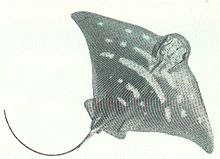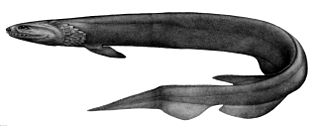
The frilled shark, also known as the lizard shark, is one of the two extant species of shark in the family Chlamydoselachidae. The frilled shark is considered a living fossil, because of its primitive, anguilliform (eel-like) physical traits, such as a dark-brown color, amphistyly, and a 2.0 m (6.6 ft)–long body, which has dorsal, pelvic, and anal fins located towards the tail. The common name, frilled shark, derives from the fringed appearance of the six pairs of gill slits at the shark's throat.
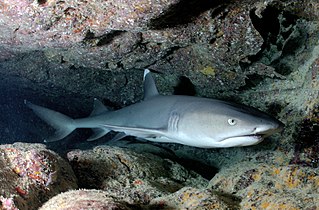
The whitetip reef shark is a species of requiem shark, in the family Carcharhinidae, and the only member of its genus. A small shark that does not usually exceed 1.6 m (5.2 ft) in length, this species is easily recognizable by its slender body and short but broad head, as well as tubular skin flaps beside the nostrils, oval eyes with vertical pupils, and white-tipped dorsal and caudal fins. One of the most common sharks found on Indo-Pacific coral reefs, the whitetip reef shark occurs as far west as South Africa and as far east as Central America. It is typically found on or near the bottom in clear water, at a depth of 8–40 m (26–131 ft).

The sharpnose sevengill shark, also known as one-finned shark, perlon shark, sevengill cow shark, sharpsnouted sevengill or slender sevengill, is a species of shark in the family Hexanchidae, and the only living species in the genus Heptranchias. Found almost circumglobally in deep water, it is one of the few species of sharks with seven pairs of gill slits as opposed to the usual five. The other shark species with seven gill slits is the broadnose sevengill shark. Though small, this shark is an active, voracious predator of invertebrates and fish. When caught, this species is notably defensive and will attempt to bite. It is of minor commercial importance.

The bat ray is an eagle ray found in muddy or sandy sloughs, estuaries and bays, kelp beds and rocky-bottomed shoreline in the eastern Pacific Ocean, between the Oregon coast and the Gulf of California. It is also found in the area around the Galápagos Islands. The largest specimens can grow to a wingspan of 1.8 m and a mass of 91 kg (201 lb). They more typically range from 9.07–13.61 kg (20.0–30.0 lb). The size of the bat ray is dependent on many factors, such as habitat alterations and different oceanographic and environmental conditions. Some bat rays are solitary, while others form schools numbering in the thousands.

The porae, the grey morwong, blue morwong, butterfish, Douglas' morwong, Eastern blue morwong, great perch, queen snapper, rubberlip morwong or silver morwong, is a species of marine ray-finned fish, traditionally regarded as belonging to the family Cheilodactylidae, the members of which are commonly known as morwongs. It is found around south eastern Australia and the north eastern coast of the North Island of New Zealand at depths of about 10 to 100 metres, on sandy and rocky coasts.

Hyporhamphus ihi, the known as the garfish, piper or by its Māori name takeke, is a halfbeak found all around New Zealand in shallow inshore waters.

The horn shark is a species of bullhead shark, in the family Heterodontidae. It is endemic to the coastal waters off the western coast of North America, from California to the Gulf of California. Young sharks are segregated spatially from the adults, with the former preferring deeper sandy flats and the latter preferring shallower rocky reefs or algal beds. A small species typically measuring 1 m (3.3 ft) in length, the horn shark can be recognized by a short, blunt head with ridges over its eyes, two high dorsal fins with large spines, and a brown or gray coloration with many small dark spots.

The bluefin gurnard or Pacific red gurnard is a species of marine ray-finned fishes belonging to the family Triglidae, the gurnards and sea robins. Its Māori names are kumukumu and pūwahaiau. It is found in the western Indian Ocean and the western Pacific Ocean, being common around Australia and New Zealand at depths down to 200 metres (660 ft). The fish is one of the most important commercial fish species in New Zealand.
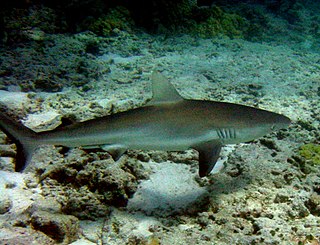
The Galapagos shark is a species of requiem shark, in the family Carcharhinidae, found worldwide. It favors clear reef environments around oceanic islands, where it is often the most abundant shark species. A large species that often reaches 3.0 m (9.8 ft), the Galapagos reef shark has a typical fusiform "reef shark" shape and is very difficult to distinguish from the dusky shark and the grey reef shark. An identifying character of this species is its tall first dorsal fin, which has a slightly rounded tip and originates over the rear tips of the pectoral fins.

Myliobatis is a genus of eagle rays in the family Myliobatidae.

The thorntail stingray, black stingray, or longtail stingray is a species of stingray in the family Dasyatidae. It is found off southern Africa, Australia, and New Zealand from the intertidal zone to a depth of 440 m (1,440 ft). This bottom-dweller inhabits soft-bottomed habitats such as lagoons, estuaries, and reefs. Growing to 1.8 m (5.9 ft) across and over 200 kg (440 lb) in weight, the thorntail stingray is among the largest stingrays in the world. Uniformly dark above and light below, it has a diamond-shaped pectoral fin disc and a very long, whip-like tail with a fin fold underneath. The upper surface of the disc and the tail bear numerous stout, sharp thorns.

The short-tail stingray or smooth stingray is a common species of stingray in the family Dasyatidae. It occurs off southern Africa, typically offshore at a depth of 180–480 m (590–1,570 ft), and off southern Australia and New Zealand, from the intertidal zone to a depth of 156 m (512 ft). It is mostly bottom-dwelling in nature and can be found across a range of habitats from estuaries to reefs, but also frequently will swim into open water. One of the largest stingrays in the world, this heavy-bodied species can grow upwards of 2.1 m (6.9 ft) across and 350 kg (770 lb) in weight. Its plain-colored, diamond-shaped pectoral fin disc is characterized by a lack of dermal denticles even in adults, and white pores beside the head on either side. The body can have colors as well as dark grey or black with rows of white spots along each wing. Its tail is usually shorter than the disc and thick at the base. It is armed with large tubercles and a midline row of large thorns in front of the stinging spine which has the dorsal and ventral fin folds behind.

The purple eagle ray is a species of fish in the family Myliobatidae. It was formerly considered endemic to Australia but is now known to be more widespread. Its natural habitat is the open seas where it has a patchy distribution, and the International Union for Conservation of Nature has assessed its conservation status as being "near-threatened".
The longnose eagle ray or snouted eagle ray is a species of fish in the family Myliobatidae. It is found in the East Pacific Ocean from Baja California and the Gulf of California to Sechura, Peru, ranging from shallow water to a depth of 64 m (210 ft). This species was first described in 1964 by the American ichthyologist Shelton Pleasants Applegate, who was an expert on fossil and living sharks, and by American marine biologist John Edgar Fitch.
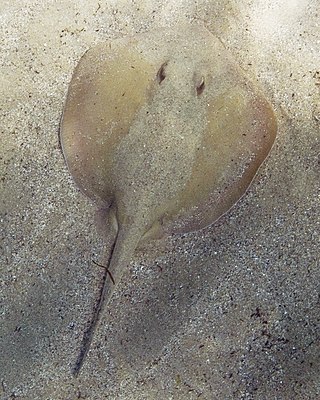
The common stingaree is a species of stingray in the family Urolophidae. The most abundant ray in inshore waters off eastern Australia, it generally inhabits estuaries, sandy flats, and rocky reefs from the shore to a depth of 60 m (200 ft). This plain brownish to grayish species has a rounded pectoral fin disc with a broadly triangular snout. Its nostrils have enlarged lobes on their outer margins and a skirt-shaped curtain of skin with a fringed posterior margin between them. Its tail bears a small dorsal fin before the stinging spine, and terminates in a leaf-shaped caudal fin. This ray can grow to 52 cm (20 in) long.

The spotted stingaree is an uncommon species of stingray in the family Urolophidae, endemic to shallow waters along the coast of southern Australia. It favors rocky reefs and seagrass beds. This species can be readily identified by its nearly circular, dark-colored pectoral fin disc, adorned with a complex pattern of white or cream spots. Its eastern and western forms differ slightly in coloration and have been regarded as separate species. There is a skirt-shaped curtain of skin between its nostrils. Its tail is fairly thick and terminates in a short leaf-shaped caudal fin; a relatively large dorsal fin is present just in front of the stinging spine.

The alligator pipefish or double-ended pipefish is a species of fish in the family Syngnathidae and is the only species in the monotypic genus Syngnathoides. It is found in shallow water in the tropical and subtropical Indo-Pacific, its range extending from East Africa to northern Australia. This fish lives in habitats of seagrass and seaweed, and hides by positioning itself vertically with its head down amidst the similar-coloured fronds of vegetation. The elongated, well-camouflaged body can reach 29 cm (11 in) in length. It feeds by sucking up its prey.

The black bream, also commonly known as the southern black bream, southern bream and blue-nosed bream, is a species of anadromous ray-finned fish of the porgy family Sparidae. A deep-bodied fish, it is occasionally confused with other similar species that occur within its range, but is generally distinguished from these species by a lack of yellow ventral and anal fins. Southern black bream are endemic to the southern coasts of Australia from Shark Bay in Western Australia to Ulladulla, New South Wales, as well as Tasmania.

The southern Mandarin dogfish is a species of Mandarin dogfish shark in the genus Cirrhigaleus. It was distinguished from Cirrhigaleus barbifer, which lives in the North Pacific, on an expedition in the coral reefs near Australia in 2007. It is now known to live in the temperate waters in south-eastern Australia and from the Bay of Plenty region in New Zealand, at depths of 146–640 metres.

Coastal fish, also called inshore fish or neritic fish, inhabit the sea between the shoreline and the edge of the continental shelf. Since the continental shelf is usually less than 200 metres (660 ft) deep, it follows that pelagic coastal fish are generally epipelagic fish, inhabiting the sunlit epipelagic zone. Coastal fish can be contrasted with oceanic fish or offshore fish, which inhabit the deep seas beyond the continental shelves.

